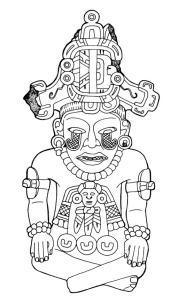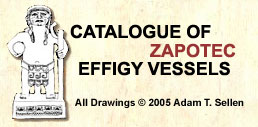| Key: MNA 6-6029 | | Actual Location: National Anthropology Museum, Mexico City, Mexico. | | Registration: 29-6 | | Provenance: Mound of tomb 41, Monte Albán, Oaxaca. | | Measurements: 32 cm. | | Color: Grey clay covered with red pigment. | | Chronology: Transition period (Caso and Bernal 1953: 250); Tani 200 - 350 AD | | Click to view Chronology | | Reference: Caso and Bernal 251: fig. 394; Richness of Ancient Mexico, Lafayette Galleries, 1994, p. 6, fig. 5. | | Comments: Caso and Bernal (1952: 250) say: "The three numerals found under the pectoral may be the ones accompanying the glyph in the headdress, which we have not been able to read, maybe because the style of this figure differs from the style we know in Monte Albán and other places of the Valley. They look more like the style we have called "San Lorenzo Albarradas", of which Linné published an urn we have already studied". (Examples in Linné, 1938: plates 14, 21). Tomb 41 dates from MA-IIIB-IV. | | Glyphs: Glyph L (Loo) in the face. Three numerals under the pectoral (3L). | |
| | 
Click to view high resolution in a new window
select this image for review |
